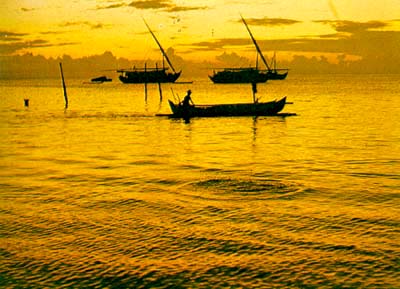
Singaraja
|
|
From the
highest point
on the mountain pass, 1,220 meters above sea level, a spectacular
descent brings you to the northern coast at Singaraja, capital of
Buleleng regency. Buleleng is a strip of land that stretches along the
whole northern coast of Bali-open to the sheltered waters of the Java
Sea, and bordering on most of the other regencies. Archaic types of
social organization and antiquities are found in many villages that are
mentioned in inscriptions dating from the 10th century onward. The
inscriptions also tell of pirate raids.
|

|
|
Throughout
it's history
Buleleng has been more open than the rest of Bali to the influence of
the maritime world of the Indonesian Archipelago and beyond. A province
before and after Majapahit conquest it rose to prominence at the end of
the 16th century under Raja Panji Sakti, who added the conquest of the
eastern tip of Java to his other successes. In 1604 he built a new
palace called singaraja on fields where men grew the grain known as
buleleng. Buleleng, gradually came to refer to the whole northern
coast. The official day of Singaraja's foundation is 30 March 1604, and
each year a festival is held to commemorate it.
|
|
Throughout
it's history
Buleleng has been more open than the rest of Bali to the influence of
the maritime world of the Indonesian Archipelago and beyond. A province
before and after Majapahit conquest it rose to prominence at the end of
the 16th century under Raja Panji Sakti, who added the conquest of the
eastern tip of Java to his other successes. In 1604 he built a new
palace called singaraja on fields where men grew the grain known as
buleleng. Buleleng, gradually came to refer to the whole northern
coast. The official day of Singaraja's foundation is 30 March 1604, and
each year a festival is held to commemorate it.
|
|
In 1814 a
British
military expedition stayed several months in Singaraja when Raffles was
governor-general. The British went, but the Dutch came, at first with
demands and later bearing arms, accusing the rajas of raiding wrecked
ships. The first attempts of the Dutch ended in defeat or stalemate.
|
|
In 1849 a
reinforced
expedition captured the Buleleng stronghold of Jagaraga, after a fierce
weeklong battle. In 1882 the Dutch imposed direct colonial rule upon
Buleleng and Jembrana. Singaraja became their capital and chief port
and remained the seat of the colonial Indonesian government for the old
Nusa Tenggara province (the Lesser Sunda Islands) until 1953.
|
|
Longer
exposed to
European influence than other parts of Bali, Singaraja has often been
in the forefront of changes in the arts, fashion (wearing the kebaya
began here), and political and social movements.
|

|
|
As an
important shipping
center, Singaraja has a cosmopolitan flavor about it. The population of
15,000 comprises many ethnic and religious groups. It is not unusual to
see an Islamic procession pass before a Chinese temple flanked by
office buildings of European design. Residential sections of the town
are named after such immigrant groups as the Bugis of Sulawesi, the
Javanese and the Chinese. After the bustle of Denpasar, Singaraja seems
subdued, no longer a leader amongst Balinese towns. A legacy from Dutch
times, however, is its continuing importance as an educational center.
|
|
The city
also houses a
historical library, the gedong Kirtya, which is the storehouse of
Balinese manuscripts, totaling some 3,000. Lontar books-leaves of the
lontar palm cut in strips and preserved between two pieces of precious
wood contain literature, mythology, historical chronicles and religious
treatises, some works relatively new, others almost a millenium old.
Miniature pictures, incised on the leaves with an iron stylus, are
masterpieces in the art of illustration. Prasastis, metal plates
inscribed with royal edicts of the early Pejeng-Bedulu dynasty, are
among the earliest written documents found in Bali.
|
|
Buleleng
is the island's
chief coffee growing area. Freighters anchored off the harbor load this
cargo for export to Europe and the Orient. The climate here is drier
than in the south. Rather than rice, the fields yield Indian corn,
oranges and crops of dry agriculture. The following temples of North
Bali are located near Singaraja. If there is time, a pleasant drive
further east between stately colonnades of trees leads to Yeh Sanih, a
shimmering pool of bluegreen, flowing from underground springs. The
clear waters have been enclosed to make a most refreshing place to
swim. All along the northern shore are sea temples.
|
Copyright
© 2001-2011, K&D Bali Designs. All rights reserved.
|